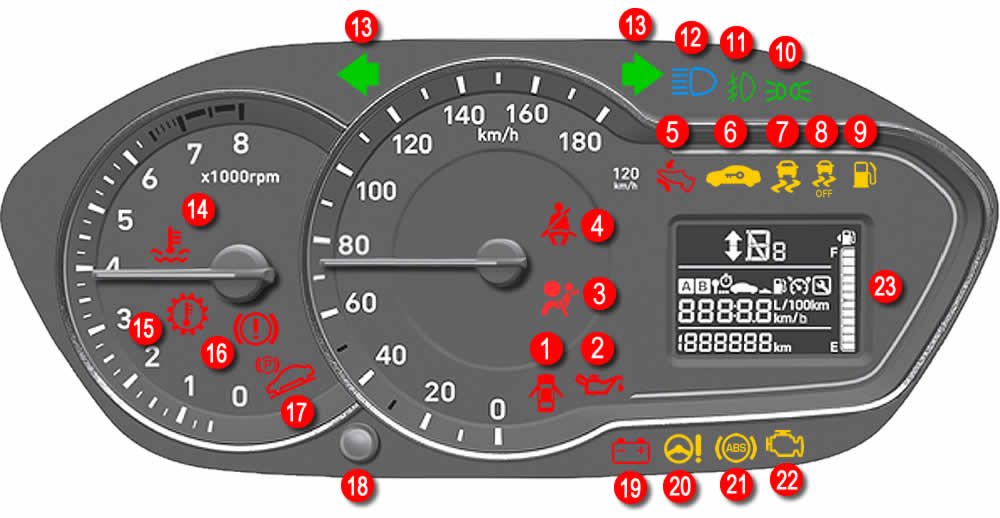Hyundai Santro Dashboard Warning Lights
The South Korean car manufacturer Hyundai produced the Santro from between 1998 and 2014, reviving the Santro in 2018. The following Hyundai Santro dashboard warning lights offer an explanation of each symbol and what action to take if a warning light illuminates. Dashboard displays will vary depending on your model.
 Door Ajar
Door Ajar
The door ajar warning light illuminates in red if one or more doors is not properly shut. If the door ajar warning light remains lit when all doors and the boot are properly shut, it’s likely the door switch is either worn and requires replacement, or is blocked with grime. Spraying the switch with a lubricating oil such as WD40 may improve the function of the door switch.
 Oil Pressure
Oil Pressure
An appropriate oil pressure inside the engine is essential for maintaining lubrication. If the red oil pressure warning light comes on while driving, stop the vehicle as soon as safely possible and switch off the engine. Low oil pressure means that engine components may not be receiving sufficient lubrication resulting in significant damage. Low oil levels can lower oil pressure. Check engine oil level and add oil if necessary.
If the warning light remains on after adding oil or if oil is not available, do not continue driving and contact a Hyundai workshop. For the best fuel economy on the Hyundai Santro, it’s recommended to use engine oil of a viscosity grade SAE 0W-20 (API Latest, ILSAC Latest).
 Airbag
Airbag
When working as expected, the Hyundai Santro airbag warning light should illuminate for 6 seconds when the ignition is switched on, then go off. If the airbag light remains on after starting the engine, it means there’s a problem with the airbag SRS (supplemental restraint system).
This may be an issue with the seat belt pretensioner system. Wired and connecters can become dislodged under the front seats. If it’s a problem with the airbag, it may relate to a fault with the sensors, the airbag module, airbag clock spring located inside the steering column, or possibly low battery charge.
 Seat Belt Warning
Seat Belt Warning
This warning light informs the driver or passengers that they need to apply their seat belt. When driving at speed of 9 km/h or more, the seat belt warning light will blink and at 20 km/h or more, an audible chime will sound for approximately 100 seconds.
 Press Brake
Press Brake
The Hyundai press brake warning light will illuminate when the vehicle is attempted to be started without first pressing the brake pedal. For automatic versions of the Hyundai Santro, this warning light also illuminates if an attempt is made to shift the gear from Park (P) into Drive (D) or Reverse (R).
 Immobilizer
Immobilizer
The car with a key symbol is the Hyundai Santro immobilizer warning light. The immobilizer warning light should come on when the vehicle detects your electronic key when the ignition is switched on. In this situation, the engine can be started. The immobilizer warning light should go off once the engine has been started. If the immobilizer warning light blinks, it indicates a malfunction with the system it’s unlikely that the engine can be started.
This may be a fault with the transponder inside the electronic key, or that the battery requires replacement. Try an alternative key if you have one. Other issues include the antenna ring around the ignition barrel, where the connections can become loose.
 Electronic Stability Control
Electronic Stability Control
Electronic Stability Control (ESC) is a safety feature that helps to improve vehicle control by reducing understeer, oversteer and improve wheel traction. If the ESC light blinks, it means the system is operating and that the vehicle is reaching the end of it’s stability limits. If the ESC light remains lit, it means there’s a fault. The ESC fault if often due to a malfunctioning wheel speed sensor. For more information, see What ESC is in Cars and How Does ESC Work in Cars.
 Electronic Stability Control Off
Electronic Stability Control Off
The ESC OFF warning light will illuminate when the system has been manually deactivated. ESC is automatically reactivated after each ignition cycle. ESC should generally be enabled at all times, with the exception of the vehicle becoming stuck in snow / mud and where you need to rock the car forwards and backwards.
 Low Fuel
Low Fuel
The illumination of the yellow fuel light means the vehicle is low on fuel. Refuel the vehicle as soon as possible. Driving when the fuel tank is nearly empty can cause engine misfire, resulting in damage to the catalytic converter.
 Lights On
Lights On
The green lights on indicator illuminates when the vehicle’s parking lights and headlights are switched on.
 Front Fog Lights
Front Fog Lights
This warning light is used to inform the driver that the front fog lights are switched on.
 High Beams
High Beams
This blue symbol illuminates to warn the driver that their high beams are on. It also illuminates when the turn signal lever is pulled to ‘flash’ another motorist or pedestrian.
 Turn Signals / Hazards
Turn Signals / Hazards
The turn signal arrows blink either left or right when the corresponding signal is applied. Both arrows blink when the hazard warning lights are switched on. If a turn signal light is blinking more rapidly that usual, it’s often a indication that one of the bulbs in the turn signals has blown.
 Engine Coolant
Engine Coolant
The engine coolant warning light will illuminate on the Hyundai Santro’s dashboard when the engine is overheating. If driving, pull off the road as soon as safely possible and switch off the engine. Allow for several minute to pass, open the hood and check coolant levels. You may need to use a cloth when opening the coolant reservoir to prevent steam escape burns. If coolant levels are low, top up. Ensure the cooling fan is working and check to ensure there are no coolant leaks under the vehicle. For further information, see red engine coolant warning light on or flashing.
 Transmission / Clutch
Transmission / Clutch
The temperature gauge in a cog symbol is the transmission / clutch overheating warning light. It comes on if there’s an unusually high lead on the automatic transmission. If the light illuminates, safely stop the vehicle to allow it to cool. A transmission can overheat if carrying a heavy load, driving up a long steep slope etc. Continued driving with the transmission temperature light on may damage the gearbox. Check to ensure transmission fluid levels are correct and that there is no lubrication leak from the gearbox. Lubrication oil in the gearbox may need changing.
 Brake / Parking Brake
Brake / Parking Brake
The red exclamation point in a circle, contained in a parentheses relates to the Hyundai Santro’s brakes. The light comes on when the parking brake is applied. If the brake light remains on when the parking brake is properly released, it means brake fluid levels are low. Check under the hood immediately at brake fluid levels in the reservoir. The Hyundai Santro requires hydraulic brake fluid conforming to DOT 3 or DOT 4 specification. It is normal for brake fluid levels to fall as brake pads wear lower, if brake fluid requires regular topping up, it may indicate a leak.
 Apply Parking Brake
Apply Parking Brake
This warning light comes on to warn that the parking brake has not been applied. The apply parking brake warning light comes on when the engine has been switched off and the hand brake has not been applied. After 5 seconds the light goes off.
 Trip Button
Trip Button
This button is the trip selector that allows you to choose between trip A or trip B. The button also acts as a reset switch.
 Electrical Charging System
Electrical Charging System
The Hyundai Santro battery warning light should come on when the ignition is switch on, but go off when the engine has started. If the light remains lit, it means there’s an electrical charging system fault. Check that the alternator drive belt is secure and tight. Another likely problem is a failing alternator, or ageing failing battery. See why is my car battery warning light on for further information.
 Electric Power Steering
Electric Power Steering
Electric Power Steering (EPS) can fail temporarily when the motor overheats. Constant steering from left to right lock or leaving the steering on full lock for an extended period while the engine is running can cause overheating. When the system has cooled, it will return to normal functionality.
 Anti-lock Braking System
Anti-lock Braking System
If the driver uses heavy braking, the anti-lock braking system (ABS) helps to prevent the wheels from locking, therefore enabling the driver to continue to steer the vehicle. If ABS fails, normal brakes will continue to operate. The usual cause of an ABS fault is due to one of the wheel speed sensors malfunctioning.
 Engine Warning Light
Engine Warning Light
The Hyundai Santro engine warning light, also called the malfunction indicator lamp (MIL) is a generic warning, meaning that many possible faults can trigger the symbol to come on. Due to there being many possible faults, diagnostic equipment is required. When the engine light illuminates, a fault code is usually generated and stored. The diagnostic equipment is used to read the fault codes and inform the user where the malfunction has occurred.
You can usually continue driving when the engine warning light comes on, however, if it begins to flash, it can mean there’s an engine misfire. A misfiring engine can cause damage, so reduce speed and avoid overworking the engine until the light stops flashing. Continued driving over a period of time may make the problem worse. Have diagnostics as soon as possible. For further information about the engine warning light, see reasons why the engine warning light is on.
 Information Display
Information Display
This digital display shows information such as trip meters, remaining fuel, gear shift indicator. fuel consumption etc. See below for details.
Information Display
This is the information that’s provided on the Hyundai Santro’s digital dashboard display.
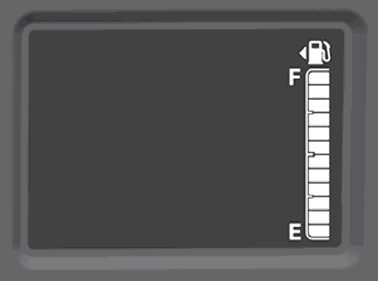
This gauge displays the remaining amount of fuel in the vehicle’s tank. When on inclines or declines, the fuel gauge may fluctuate.
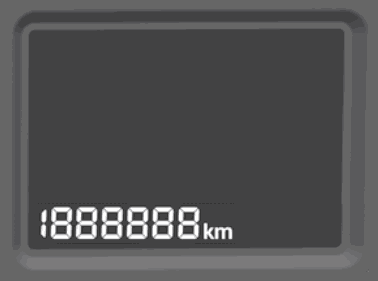
The odometer displays the total distance that the Santro has been driven. The odometer range can be adjusted to miles or kilometres and should be used to determine periodic vehicle maintenance.
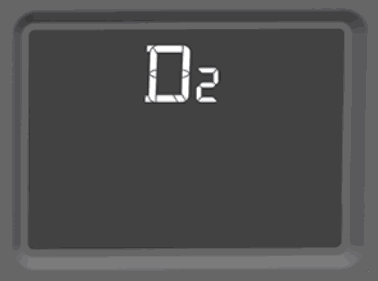
For automatic versions of the Hyundai Santro, this displays the current gear and mode. For example:
Reverse: R
Neutral: N
Drive mode: D1, D2, D3, D4, D5
Manual mode: 1, 2, 3, 4, 5
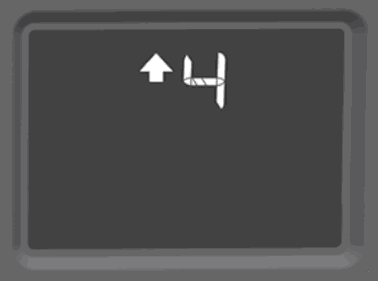
For manual versions of the Hyundai Santro, this displays which gear is recommended for fuel saving purposes. For example, the display is recommending that you shift up to 4th gear. When the upwards arrow is displayed, change up to the recommended displayed gear and if the downwards arrow displays, change down to the recommended displayed gear.
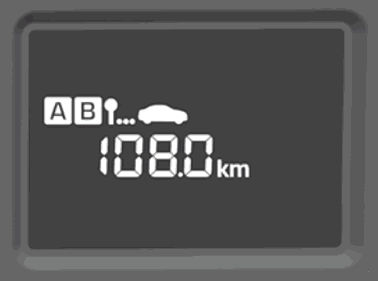
The Hyundai Santro trip meter displays the distance of individual trips made. Two trip meters are available; trip meter A and trip meter B.
To reset the trip meter, press and hold the trip mode/reset button (18).
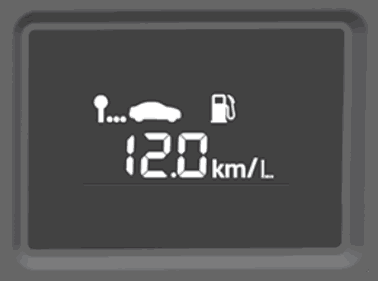
The setting calculates the average fuel consumption from the total amount of fuel used since it was last reset.
Pressing and holding the trip mode/reset button (18) for more than one second will reset the average fuel consumption to zero.
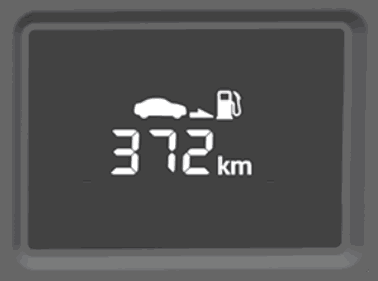
This display indicates the estimated remaining distance to empty. This is calculated on the amount of fuel remining in the tank and the amount of fuel delivered to the engine (driving style, speed etc).
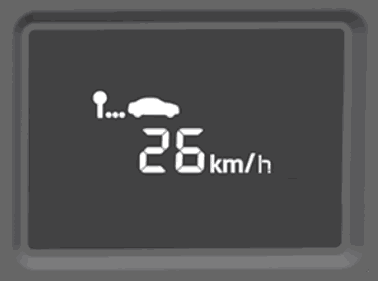
This mode calculates the average speed of the vehicle since the last average speed reset.
To reset the average speed, press and hold the trip mode/reset button (18).
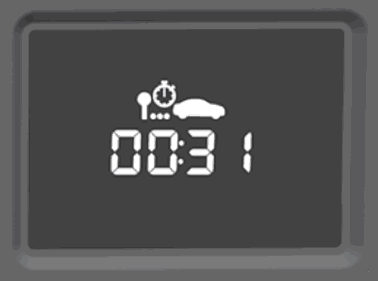
This mode will calculate the total time you have travelled since the last elapsed time was reset. The elapsed time will continue even if the vehicle is not in motion, but as long as the engine is running. To reset the elapsed time, press and hold the trip mode/reset button (18).
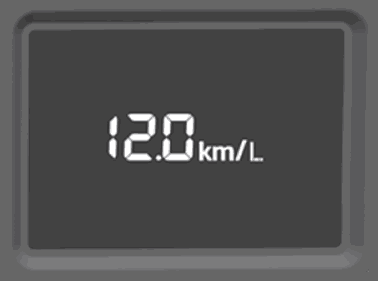
This readout displays the instant fuel consumption of the vehicle, indicated over the last few seconds.
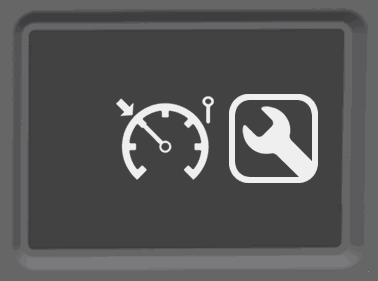
If available, these symbols represent the cruise control function, speed limiter function and the spanner / wrench symbol represents the scheduled vehicle main
